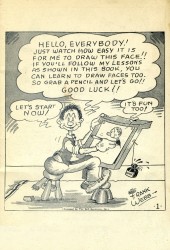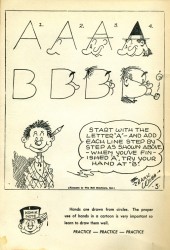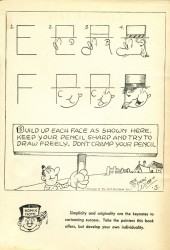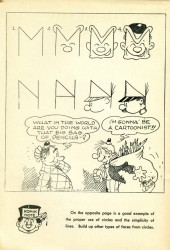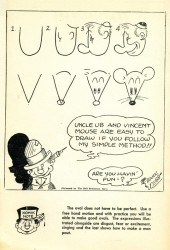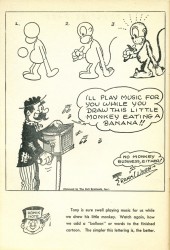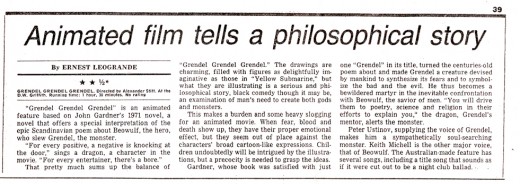Category ArchiveBooks
Books &UPA 04 Sep 2006 09:45 am
Cartoon Modern
- I hope I’m not sounding like a shill, but I don’t really mind. I believe in the product, and I’m going to broadcast my enthusiasm until you’ve got tears in your eyes.
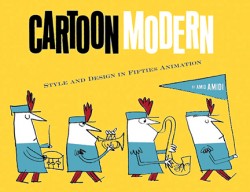 Amid Amidi’s book Cartoon Modern is the best book on animation I’ve encountered since Michael Barrier’s Hollywood Cartoons.
Amid Amidi’s book Cartoon Modern is the best book on animation I’ve encountered since Michael Barrier’s Hollywood Cartoons.
When Barrier’s book came out, I was depressed and could find no inspiration in anything animated. As a matter of fact, I didn’t want to see any more animated films. I read his book and found the charge I was looking for. I reread the book and found more. Just getting some trustworthy version of some of the pioneers and artists who pushed their way through the medium did it for me. I found new life in the work I did after that. I reread that book at least once a year – just for the pleasure.

(An Eyvind Earle study for Sleeping Beauty.) . . . (All images enlarge by clicking.)
Cartoon Modern has had a similar effect. The story, here, isn’t about the pioneers who built a business and an artform; it’s about the artists who rebelled from that business to advance the art. Their story is every bit as thrilling and certainly as much of an inspiration. This is especially so in that I grew up while these guys developed the look they advanced. In some small way I was taught – through their cartoons – that modern art was good. Also, as a small business animator, how could I not associate with these guys?
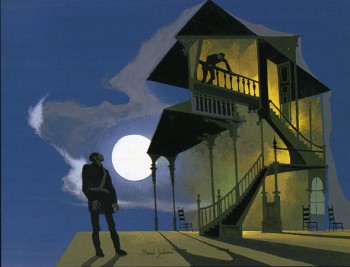 This book is filled with glorious illustrations as only such a story could be told. We are talking about people who found a way to update the art and break the mold of the 19th Century.
This book is filled with glorious illustrations as only such a story could be told. We are talking about people who found a way to update the art and break the mold of the 19th Century.
I’ve recklessly copied a couple of the stills from the book to illustrate how magnificent Amid’s photo research is to illustrate his text. It involved more than going to one archive and having them open their wares to you.
(Paul Julian’s painting for UPA’s “The Telltale Heart.”)
Amid had to go to many artists who shared the wealth. That, let me tell you, is a trying job. None of the difficulty is apparent here. Just the love. Love of the material and the medium.
Amid Amidi has a lot in common with Michael Barrier. 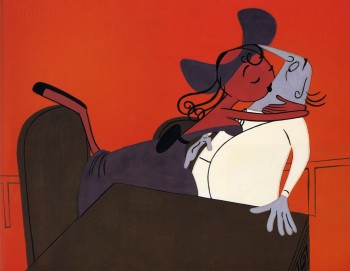
They’re both fine writers, articulate and intelligent. Both are in love with the medium, and neither is afraid to call a spade a spade or a bad cartoon a bad cartoon. You don’t always have to agree with them, just agree to listen.
For this quality, as a writer, you have to have more than a little responsibility.
Your sense of taste has to be impeccable and your audience has to trust you.
(Cel set-up from “Rooty Toot Toot.”)
Amid gained my trust and my affection for his writing years ago – thank heaven for the internet! Animation Blast, Cartoon Modern (the website), and Cartoon Brew have all informed me in a deep and solid way.
My delight in this book couldn’t be more sincere.
I haven’t completely finished reading it, and I do have a couple of quibbles. But that would have been the case of any book. However, this book is all about taste, and I’m so pleased to be in the hands of such a fine writer and historian – it’s a great feeling.
Books 17 Aug 2006 07:16 am
More Books
![]()
- Having featured a book from 1940 these past few days, I think it’s time to bring things up to date. There are a couple of books about to be released, and I’d like to make mention of them.
Animated News posts the complete press information for Tony White’s new book, Animation from Pencils to Pixels.
Tony White, of course, was the brilliant animator who rose in Dick Williams’ Soho studio (animating the Pink Panther credits), winning the BAFTA award for his brilliant short, Hokusai.
He also wrote the invaluable animation production book, The Animator’s Workbook. (This is one book I don’t think any potential animator should be without.)
After the brilliant first book, I’m looking forward to his second book. It obviously takes the 2D animator into the digital age – as has Tony White, himself.
 – Everyone knows about the release of Amid Amidi‘s book, Cartoon Modern: Style and Design in 1950s Animation .
– Everyone knows about the release of Amid Amidi‘s book, Cartoon Modern: Style and Design in 1950s Animation .
I’ve already posted several times about it, but that gives you an indication of how much I’m anticipating it. The book is a special event since it’s the first to really highlight the more eccentrically designed animation of the 50′s and early 60′s. This is a point in the era of animation that has been sorely bypassed by most animation historians.
Hopefully this book will help fill the gap. If it’s anything like Amid’s companion site, Cartoon Modern, it’ll be a gem.
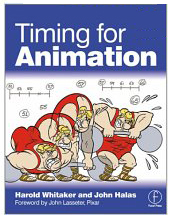 – Finally, I’d like to highlight a slightly older book that’s very much in print, but rarely do you hear anyone promote it. Timing for Animation is a book written by Harold Whitaker. Harold was the principal animator at the Halas & Batchelorstudio. He led animation on Animal Farm and Ruddigore. His style in those films was quite distinctive, and there’s no doubt he was a quiet, unheralded master.
– Finally, I’d like to highlight a slightly older book that’s very much in print, but rarely do you hear anyone promote it. Timing for Animation is a book written by Harold Whitaker. Harold was the principal animator at the Halas & Batchelorstudio. He led animation on Animal Farm and Ruddigore. His style in those films was quite distinctive, and there’s no doubt he was a quiet, unheralded master.
The book is brilliant in that it gives quite a few animation tips in simple, clear language, easily understood. I used it as a primer for my students for the short time I taught animation. I advise you all to at least look at it; you’ll end up buying it if you want to know about animation mechanics.
Animation Artifacts &Books 16 Aug 2006 07:24 am
Turney 4 – Final
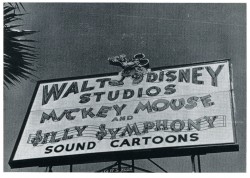 – Here are the remaining stills from the book by Harold Turney, “Filmguide’s Handbook to Cartoon Productionâ€. These remaining stills show the technical parts in completing the film: camera operators, sound effects people, musicians and editors.
– Here are the remaining stills from the book by Harold Turney, “Filmguide’s Handbook to Cartoon Productionâ€. These remaining stills show the technical parts in completing the film: camera operators, sound effects people, musicians and editors.
There are a few remaining stills in the book, but they’re predominantly shots of model sheets. All of them are available elsewhere (as are the models posted below.)
(As always, click on any image to enlarge.)
I doubt many will be able to identify any of these people, but if you know someone, please don’t hesitate to leave a comment. Unfortunately, with few exceptions, not too many people know who the non-animation personnel were.
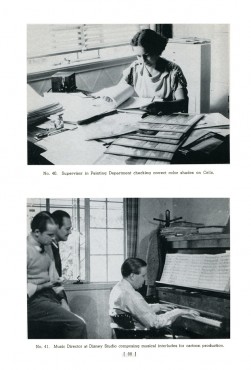
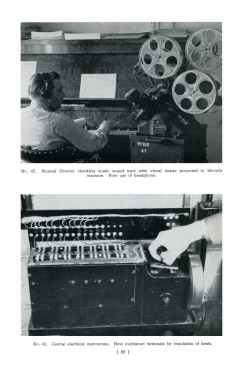
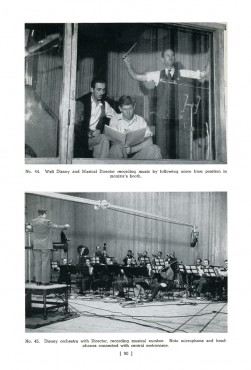
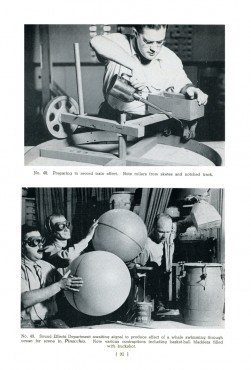
In the above left we see Disney, director, Wilfred Jackson and composer, Frank Churchill. The FX man in the upper right picture is Jim MacDonald, who voiced Mickey Mouse after Disney finally gave up the role in 1946.
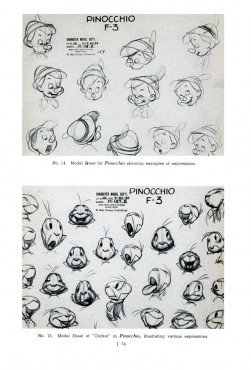
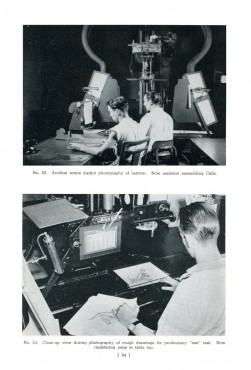
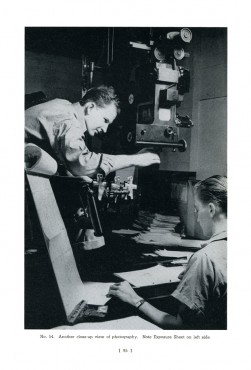
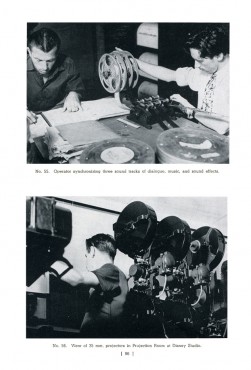
Animation Artifacts &Books 15 Aug 2006 08:10 am
Turney 3
The following is another group of photos from my copy of Harold Turney’s book “Filmguide’s Handbook to Cartoon Production” which was made up the last two postings on this site. The remainder of the photos shows some model sheets and audio effx and technical people at work. I will probably post those tomorrow. Here’s to more people to identify.
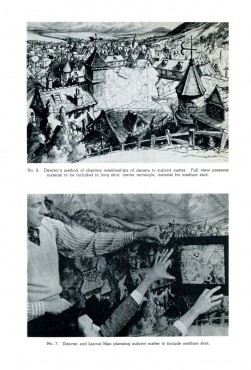
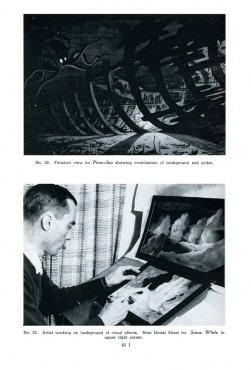 (Click on any image to enlarge.)
(Click on any image to enlarge.)
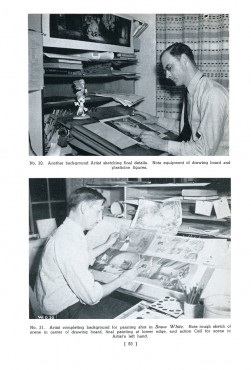
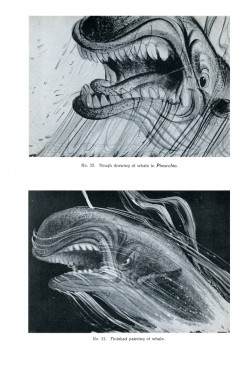
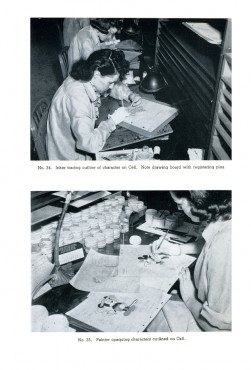
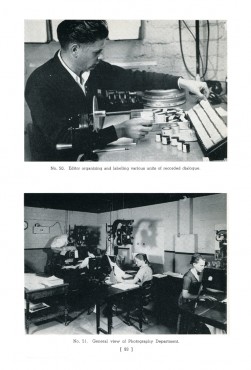
The bottom right photo shows pencil test camera operators at work. Nice to see a female filming, though a subsequent photo in the book shows a woman at work on final animation photography.
Animation Artifacts &Books 14 Aug 2006 06:42 am
Turney 2
Here are a couple of provocative articles about animation:
- The Cartoon Conundrum. A NYPost article about the marketability (or not) of star voices in animated films. here
- A British article about the rise of “Adult” themed animated features. here
The Turney Book
- Continuing yesterday’s post, there are a number of photographs in Harold Turney’s “Filmguide’s Handbook to Cartoon Production. 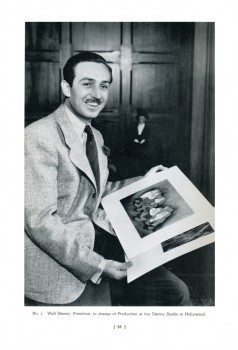 Many of the photographs are unique to this volume, and I wasn’t able to scan more of them yesterday.
Many of the photographs are unique to this volume, and I wasn’t able to scan more of them yesterday.
It’s an odd little book, held together with two staples. However any publication on the animation process was a rarity in 1940. Aside from the Lutz book and Nat Falk’s book on Terrytoons, there’s little more.
The book includes this dedication: “Cartoon Production” is herewith dedicated to all teachers, club group leaders, and librarians as an enduring aid in answering the oft-repeated question, “How are cartoons made?” – H.T.
I don’t know where the book was sold, though I do know that many of the people in the studio were given a copy. It seems to have been part of a subscription offering. I find it a bit odd that you don’t see many copies of it around. This is the only copy I’ve ever seen.
I’ll post more of the photos tomorrow.
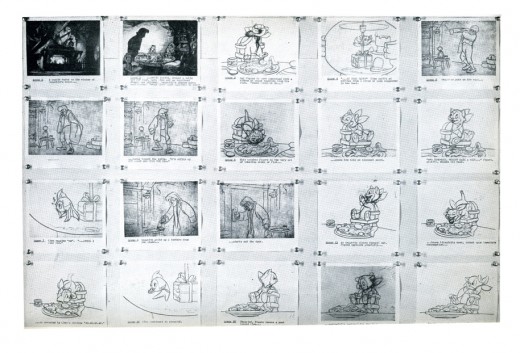 (Click on any of the images to enlarge.)
(Click on any of the images to enlarge.)
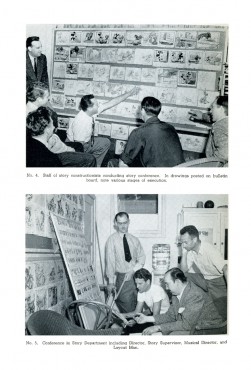

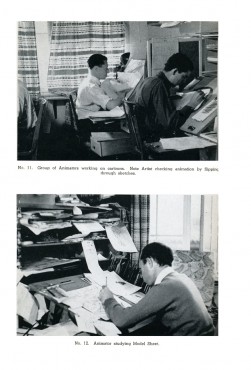
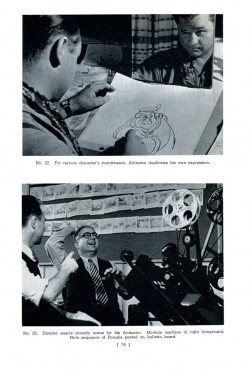 Just above, the photo on the upper left shows two animators. I believe the animator on the right is Norm Ferguson. I’m not sure who any of the others are though I would guess the director at the movieola in the photo on the lower right is Jack Cutting, director of The Ugly Duckling (the pictures behind them), who appears in yesterday’s post.
Just above, the photo on the upper left shows two animators. I believe the animator on the right is Norm Ferguson. I’m not sure who any of the others are though I would guess the director at the movieola in the photo on the lower right is Jack Cutting, director of The Ugly Duckling (the pictures behind them), who appears in yesterday’s post.
If anyone out there can identify any other of these artists, please leave a comment.
Animation Artifacts &Books 13 Aug 2006 08:43 am
Treasures
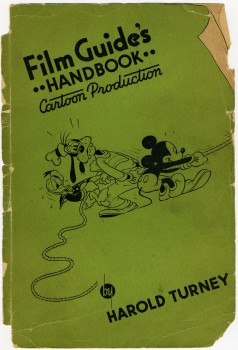 – This Harold Turney “Filmguide’s Handbook to Cartoon Production” is one of the things I treasure in my little collection.
– This Harold Turney “Filmguide’s Handbook to Cartoon Production” is one of the things I treasure in my little collection.
It was smallish book published in 1940. Apparently, there was a whole series of these books about film production. It has about 65 pages of print on heavy newsprint paper followed by about 20 pages of B&W photos on semi-gloss paper. Many of the photos printed there don’t seem to have appeared in many other places. (Though I’ve found one or two lately on the internet.)
The pictures are almost wholly those of Pinocchio’s production.
I’m posting a few of the pages. There are several to do with animators. The only picture posted here shows Fred Moore at his desk (cigarette in hand). The model maker below him is pictured with a marionette behind her. That marionette was merchandised; I have one. These were pre-plastic days. It’s made of some wood pulp product, very interesting to me. There’s also an odd studio photo of Disney manipulating the same marionette.
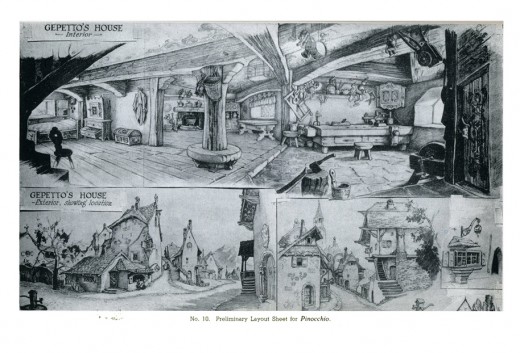
(Click on any image to enlarge.)
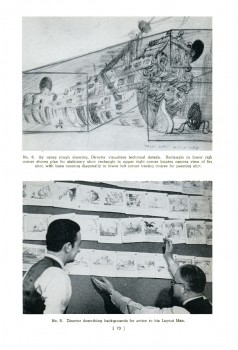
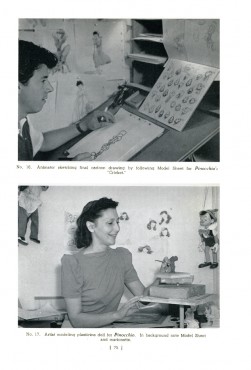
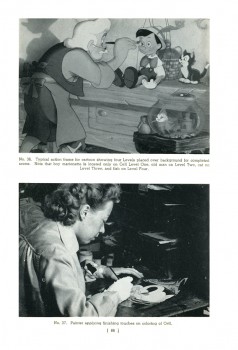
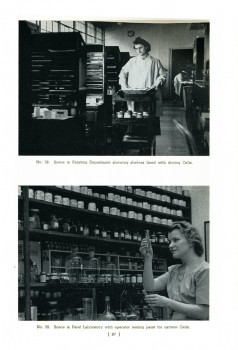
Books &Illustration 10 Aug 2006 08:39 am
Faces
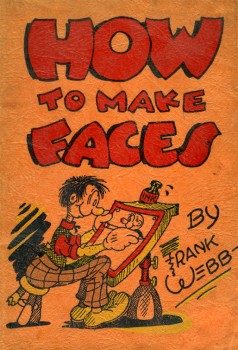 – Time to perk things up. Let’s draw faces!
– Time to perk things up. Let’s draw faces!
These pages are taken from a book I have, published in 1940, called How To Make Faces. The author, Frank Webb, was a comic strip cartoonist who drew the cartoon panel ‘Kartoon Kollege’ from 1940-41. When this strip ended, he created the comic strip ‘Raising Kane’, which ran until 1944.
Other than that, I haven’t been able to learn much about him. I find it interesting that he signed each page of his book almost as if he expected it to run in a newspaper on a daily, one-page-at-a-time basis.
His approach was to use the alphabet and build up from there. When he runs out of the alphabet, he just turns to shapes then just asks you to copy his picture or finish the page.
Every other page is a blank “Practice Page.” A nice way to fill up a book.
(Click on any image to enlarge)
Books 26 Jul 2006 07:23 am
2 Novels about Walt
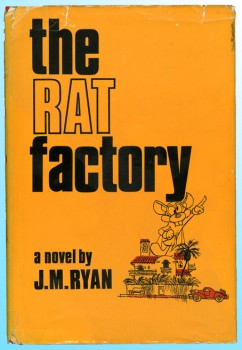
- Back in the 1970′s there was some conversation heard in animation circles about a novel, The Rat Factory, by JD Ryan, the pseudonym for a former Disney inbetweener named Jim McDermott. The novel, it was said, was about the dark side of working for Walt Disney. How a lowly, underpaid employee could get caught up in borrowing from the studio and not being able to ever get his head above water again. The myth about this book continued over my early years in animation.
Since I collected books about animation, and since my interest was obviously piqued, I started to search for this book. However, it was just not a book that could be found. A number of outfits that searched for hard-to-get books, couldn’t locate a copy. I gave up.
That changed when ebay entered the picture, and sure enough, I found and bought the book.
The hype was too much, and the book didn’t live up to the advance notices by people who, supposedly, read it. Ward Ezekial Sampson, is a thinly disguised Disney, the creator of Ricky Rat, Dizzy Duck and Dirty Dog. (None of those names are half as believable or creative as Mickey, Donald or Goofy.) The lead, Ambrose, gets the inbetweening job and is involved in the studio, but a lot of time is spent with his unlikely friends: Darlene Barff – a majorette; his landlady – who flaunts her nudism and tries to seduce him; Ezzy – a cultist who worships, trees and lizards. Not enough time is spent in the studio and the politics therein.
The book by J.M. Ryan, is not very well written, nor is it a great read. One isn’t really convinced that the writer and former illustrator actually was an inbetweener; there are few turns to reveal much that couldn’t have been learned with a good interview or three. In fact, it’s no more realistic than was the material visualized in “The Duck Factory,” the old, short-lived Jim Carrey tv show.
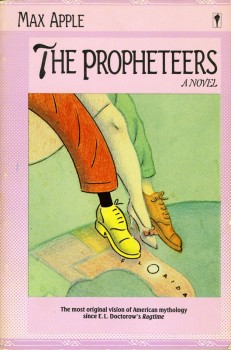 – A much more exciting, enjoyable read is Max Apple‘s novel, The Propheteers. This book is the outgrowth of a long short story by the author, The Oranging of America (available in the short story collection of the same name). It’s such a fun read that I’ve gone through the book at least three times.
– A much more exciting, enjoyable read is Max Apple‘s novel, The Propheteers. This book is the outgrowth of a long short story by the author, The Oranging of America (available in the short story collection of the same name). It’s such a fun read that I’ve gone through the book at least three times.
In Apple’s story, Walt and his older brother, Will (Roy, in real-life), vie for some land in Orlando, Florida. Their competition is Howard Johnson who wants to build Johnsonland, a nature-lover’s Audobon Society version of Disneyland for older folks. The cross country race to buy up the land involves C.W.Post and his Post Cereals in Michigan, and the Birdseyes with their frozen foods. None of it, of course, is reality, and yet all of it is. It’s hilarious.
Here’s a sample. A fake history tells the story of Mickey Mouse, and in the following section Will (i.e. Roy) gives Walt a pep talk:
“In fact, for the cruise over Orlando the Disney brothers made one of their rare changes in itinerary. Usually they did not travel in the same aircraft or even stay at the same hotel. Walt could not leave California without being skeptical about all the past Mickey Mouse business.
“We did the goddamn mouse thing,” he said often, “and that’s enough. How many goddamn mouse things can a man do?”
Will Disney had the personality to complement his brother’s genius. “Walter,” he would say, “once you get people listening to a talking mouse you have got them, brother, by the nuts.” Will called his brother’s creation “Milky Mouse,” because he could milk it for all it was worth.
Years after making it big, Walt still had no confidence. Money in the bank did little to bolster him. Becoming an international celebrity only made him think less of the world. “Sometimes I think, Will, that one of these mornings I’m just going to wake up and find out that it’s all over. The Mouse, Donald, Pluto, Scrooge, Minnie, the nephews, the comic books, the whole drafting department gone like a flushed toilet.”
“Yes,” Will said, “but if that ever happens your shoes and your bed and your house and California and New York will all be gone too. When are you going to realize, Walter, that what we have is a product, the same as cars and food and clothes?
When are you going to stop whining about Mickey and Donald and wake up to the whole damn industry? Did Henry Ford worry that someday people would stop buying the Model T? The hell he did. For twenty years he wouldn’t even give ‘em a second color. Do farmers sit around on their butts not planting seed just in case there’s going to be a drought next summer? And what about the whole damn clothing industry? On just about any day, people can stop buying new duds and make do for a couple of years. That don’t scare the shit out of Seventh Avenue. Hell, no, it just makes people work harder, take bigger risks. It keeps things interesting, Walter, and you and I, brother, we’re in the most interesting business of all.”
Will could always bring him out of the dumps with his little pep talks. He had to remind Walter that they were part of a big, wide, profitable world.
Animation &Books 30 Jun 2006 07:33 am
Grendel
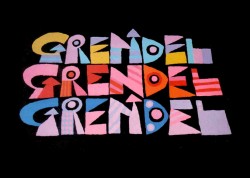 – Grendel, the opera, directed and adapted by Julie Taymor from John Gardner‘s novel recently opened in San Francisco to good reviews. There’s an excellent review on the site The Lemmings Were Here, and there’s another by animation composer, Ross Care, at Music From The Movies. (You’ll remember Ross’ commentary on the Bambi dvd.)
– Grendel, the opera, directed and adapted by Julie Taymor from John Gardner‘s novel recently opened in San Francisco to good reviews. There’s an excellent review on the site The Lemmings Were Here, and there’s another by animation composer, Ross Care, at Music From The Movies. (You’ll remember Ross’ commentary on the Bambi dvd.)
The opera is set to open July 11th at Lincoln Center as part of its Lincoln Center Festival.
(Click on any image to enlarge.)
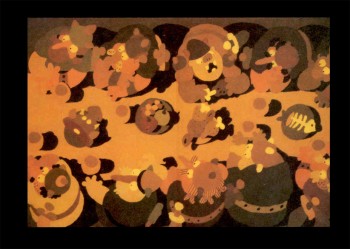 For those long-hearted animation afficionados, you’ll remember that there was an animated feature based on this same book. Grendel Grendel Grendel was an Australian film directed by Alexander Stitt. Stitt was a commercial director/producer down under. He put all his chips into this film and gave it a dynamic style. As a matter of fact, his house style seemed to be limited animation without outlines on his characters. Unfortunately, the script and the direction was bland, and the dynamic book died as a film. It also wasn’t distributed widely, nor was it marketed well.
For those long-hearted animation afficionados, you’ll remember that there was an animated feature based on this same book. Grendel Grendel Grendel was an Australian film directed by Alexander Stitt. Stitt was a commercial director/producer down under. He put all his chips into this film and gave it a dynamic style. As a matter of fact, his house style seemed to be limited animation without outlines on his characters. Unfortunately, the script and the direction was bland, and the dynamic book died as a film. It also wasn’t distributed widely, nor was it marketed well.
At the bottom of this page, I’ve included a saved copy of the NYDaily News review, in case you’re interested.
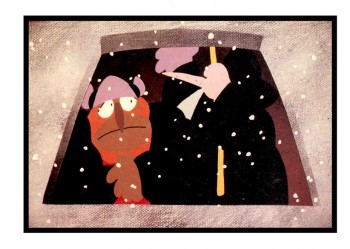 I have some interest in this opera and animated film because of my connection to the book.
I have some interest in this opera and animated film because of my connection to the book.
Back in 1976, when I’d first started working at Raggedy Ann & Andy, I was thoroughly grabbed by the book and felt that it would make a wonderful animated feature. I did the unconscionable move of the innocent; I wrote to the author, John Gardner, c/o his publisher. I told him that we could make a great film and would somehow raise the money. It wasn’t the greatest concern. (I said I was innocent.)
Believe it or not, John Garder wrote back and said he was interested. The fact that I’d worked on one of his favorite animated shorts, Cockaboody, gave him a bit more interest in me. We eventually hooked up, and he gave me a couple of stories to tell just with that first evening when we met at his home in Bennington, Vermont. It was a real trial of an evening which ended with an all night bout of martini drinking and conversation.
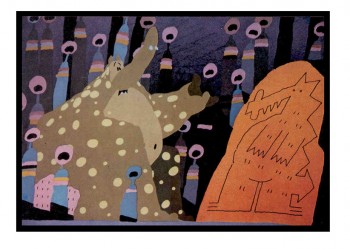
I ended up with the rights to the book, and John Gardner, himself, would write the screenplay. The problem was that I was that innocence I spoke of. A real neophyte, I didn’t raise the money, and the project stagnated in my hands.
I came close when an executive at United Artists was sold on it, and wanted to go. She was a real mover in the company and had clout. Unfortunately, UA collapsed in scandal, and MGM bought the company outright eliminating all execs, including my contact. I came close in selling it to Cinema V, who had just had a good hit in Terry Gilliam’s Jabberwocky.
I have no doubt that I would be able to sell it today if I went out with the materials I had in hand and that selling point, John Gardner’s name. I’d also found a couple of celebrities who were willing to connect to it – including Paul McCartney. But it wasn’t to happen.
Gardner had a hard divorce, came down with cancer (which he overcame), and owed a lot of back taxes. He had to sell the project to an Australian filmmaker who offered cash. My last ditch effort before he sold it was to call Roger Corman. Corman took my call (the magic of John Gardner’s name) and tried to think how we could raise, at least, the $25,000 to secure the rights. He asked me to give him a week. At the end of the week, Corman decided to let it go, and I had to surrender.
I did get invited to the Alexander Stitt film when it played in NYC. It only stayed at that one theater for a couple of weeks, then it too disappeared. But I got an interesting lesson in life. I also have some incredible memories of John Gardner; I illustrated a couple of his books.
I look forward to Julie Taymor’s opera.
Books &Festivals &Mary Blair 19 May 2006 06:26 am
Cannes & Walt’s People
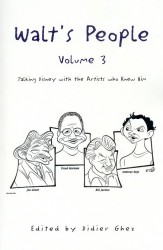 - In case you haven’t heard of Didier Ghez‘ three volume set of interviews published as Walt’s People Vols.1 & 2 and, just released, Vol. 3, you should look into it.
- In case you haven’t heard of Didier Ghez‘ three volume set of interviews published as Walt’s People Vols.1 & 2 and, just released, Vol. 3, you should look into it.
The books give a number of excellent in depth interviews with different artists who’ve worked with Walt Disney over the course of his career. They’re a wonderful tool for anyone interested in animation history and a good read for anyone interested in animation.
The most recent volume #3 includes interviews with: James Algar, Lee Blair, Joe Grant, Ben Sharpsteen, Bill Justice, Volus Jones, Ward Kimball, Burny Mattinson, Floyd Norman, and Bill Peet.
The first book features interviews with: Rudy Ising, Dave Hand, Bill Tytla, Ken Anderson, Jack Hannah, John Hench, Marc Davis, and Milt Kahl.
The second book includes: Friz Freleng, Grim Natwick, Frank Tashlin, Ward Kimball, Floyd Gottfredson, Frank Thomas, Eric Larson, and Woolie Reitherman
If you go to the Xlibris site, the primary distributor, you can get a sample of the interviews conducted within each of the books.
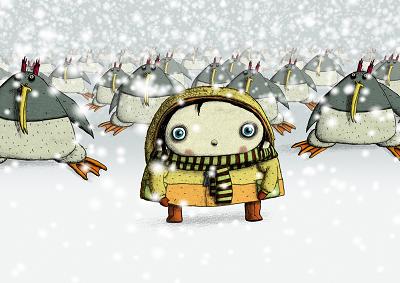 – The 2006 Cannes Film Festival, currently in progress, has only two animated shorts in competition this year. One French, one Swiss. They are:
– The 2006 Cannes Film Festival, currently in progress, has only two animated shorts in competition this year. One French, one Swiss. They are:
Icefloe is a Swiss animated film directed by Cédric LOUIS and Claude BARRAS.
The film tells the story of Marine, an obese young girl, who suffers from the heat of summer and the way other people look at her. She dreams of a better life among the penguins on an ice floe.
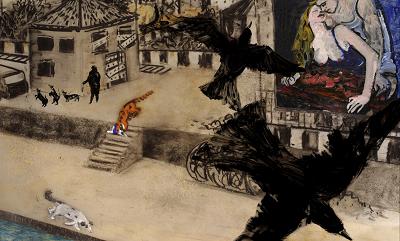 Conte De Quartier – A French film directed by Florence MIAILHE.
Conte De Quartier – A French film directed by Florence MIAILHE.
In a neighbourhood about to be torn down, construction wrecking ball in sight, seven characters cross paths. A rag doll with an inner secret is relayed from one character to another, creating a skein of tangled destinies inspired by tabloid news items.
Florence Miailhe used sand-and-oil-paint-on-glass animation and a digital camera to make the film. Technically it feels a bit like the style developed by Caroline Leaf in The Street.
You can see a sample of it here.
Neither film is listed in competition or Panorama at Annecy or Zagreb. Maybe Ottawa?
- Mark Mayerson has posted a fabulous letter by Dick Lundy, dated 1978, which gives a first person breakdown of his own career. It’s quite remarkable and an entertaining read.
